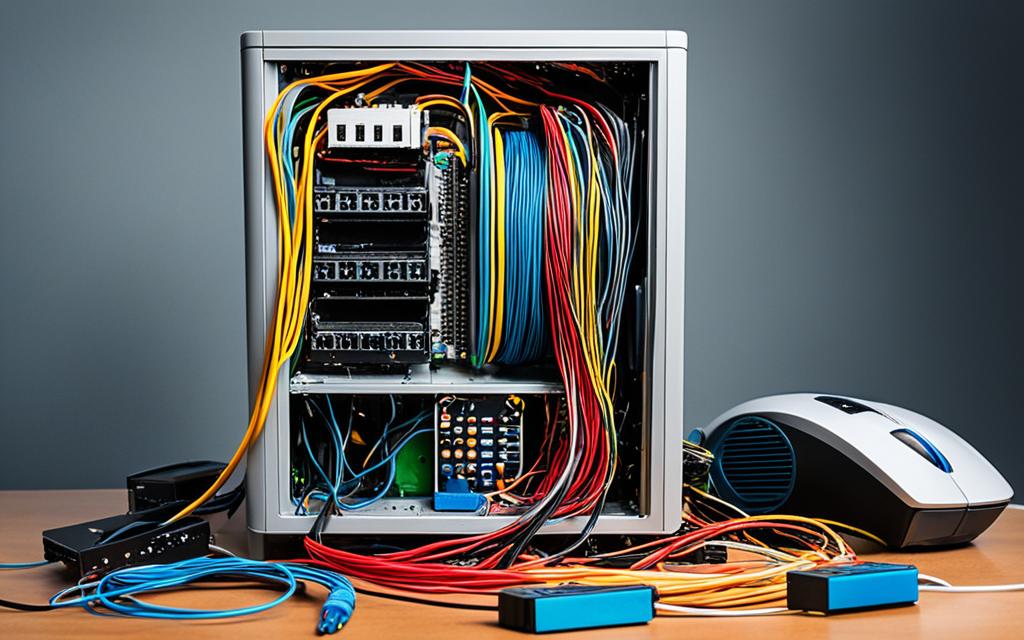Fixing Desktop Computers That Won’t Shut Down
If you’re experiencing difficulties shutting down your desktop computer, you’re not alone. It can be frustrating when your computer won’t shut down, leaving you wondering what could be the issue. In this article, we will explore various troubleshooting steps to help you resolve the powering down problems with your desktop computer. Whether it’s a shutdown issue fix, incompatible Windows updates, or unwanted running applications causing the problem, we’ve got you covered.
To effectively troubleshoot the issue and find the right solution, it’s essential to understand the possible causes. Some common reasons for desktop computers not shutting down properly include a faulty file system, incompatible Windows updates, the fast startup feature, or unwanted running applications. By addressing these issues, you can regain control over your computer’s shut down process and prevent any data loss that may occur during a forced shutdown.
Stay with us as we delve into different solutions to tackle the problem of desktop computers that won’t shut down. From force shutting down your computer to using the Run box and Command Prompt, we will guide you step-by-step through each method. By the end of this article, you’ll have the knowledge and tools to troubleshoot and resolve this frustrating issue, ensuring a smooth shut down experience every time.
Solution 1: Force Shut Down your Computer
If your desktop computer won’t shut down using the regular method, you can try force shutting it down. However, it’s important to note that forcefully unplugging the system can cause damage to the power supply, the motherboard, or other components.
To safely force shut down your computer, press and hold the power button for 5 to 10 seconds until the PC shuts down completely.
| Steps to Safely Force Shut Down your Computer |
|---|
| 1. Press and hold the power button for 5 to 10 seconds |
| 2. Wait for the PC to shut down completely |
| 3. Remove the power source from the computer |
| 4. Wait for 5 to 10 minutes |
| 5. Reconnect the power source |
| 6. Start the system again |
If the PC shuts down normally after following these steps, the issue is resolved.
Solution 2: Use the Run Box to Shut Down Windows
If you’re looking for an alternative method to shut down your Windows computer, using the Run box can be a convenient and efficient option. The Run box allows you to execute commands and perform various tasks on your system effortlessly. To access the Run box, simply press the Windows key + R on your keyboard.
Once the Run box appears, you can proceed to type in the command that will initiate the shut down process. For a smooth and prompt shutdown, enter the following command:
shutdown /s /f /t 0
After entering the command, press the enter key to execute it. Your computer will then begin shutting down immediately.
This method enables you to bypass any potentially obstructive programs or processes that might prevent a regular shutdown. It allows for a swift and direct shutdown, ensuring that your computer powers off completely.
Benefits of Using the Run Box for Shutting Down
The Run box provides a hassle-free way to shut down your Windows computer quickly. Here are a few advantages of using this method:
- Efficiency: The Run box allows you to initiate the shutdown process with a single command, saving you time and effort.
- Direct Shutdown: By using the Run box, you can bypass any unnecessary steps or processes and shut down your computer directly.
- Accessibility: The Run box is easily accessible through the Windows key + R shortcut, making it convenient for regular use.
This method can be especially useful when you need to shut down your computer promptly or when other conventional shutdown methods are not working as expected.
Solution 3: Shut Down Windows Using Command Prompt
If you’re unable to shut down your computer using the regular method, you can troubleshoot by shutting it down using Command Prompt. This method allows you to exert more control over the shut down process.
To shut down your Windows computer using Command Prompt, follow these steps:
- Open Command Prompt as an administrator: Press the Windows key, type “Command Prompt,” right-click on the Command Prompt app, and select “Run as administrator.”
- Type the shut down command: In the Command Prompt window, type the following command: shutdown /p
- Press Enter: Hit the Enter key to initiate the shut down process.
Using Command Prompt allows you to shut down your system without installing any pending updates that may be causing issues. This can be especially useful if you’re troubleshooting a problem or if you need to shut down your computer quickly.
Remember to save any unsaved work before shutting down your computer using Command Prompt.
By following these steps, you’ll be able to shut down your Windows computer efficiently using Command Prompt.
If you’re looking for a visual step-by-step guide, refer to the table below:
| Step | Description |
|---|---|
| 1 | Open Command Prompt as an administrator |
| 2 | Type the command “shutdown /p” |
| 3 | Press Enter to shut down the computer |
Following these instructions will allow you to effectively shut down your Windows computer using Command Prompt and overcome any shutdown issues you may be experiencing.
Solution 4: Quit the Open Apps and Kill Processes to Shut Down the Computer
Sometimes, open applications running in the background can prevent your computer from shutting down. To fix this issue, you can use the Task Manager to quit the open apps and kill the processes.
Right-click on the taskbar, select Task Manager, go to the Processes tab, and end the tasks for each app running in the background. Once all the processes are closed, you can proceed to shut down your computer using the regular method.
If you’re not sure which apps are causing the problem, you can use the Task Manager’s “CPU” and “Memory” columns to identify the ones consuming the most resources. This will help you prioritize the apps to close and speed up the shutdown process.
Remember, ending critical system processes can cause stability issues or program crashes. It’s important to exercise caution and only close the apps and processes that you are familiar with.
| Steps to Quit Open Apps and Kill Processes using Task Manager |
|---|
| 1. Right-click on the taskbar |
| 2. Select Task Manager |
| 3. Go to the Processes tab |
| 4. Identify the apps consuming the most resources |
| 5. Right-click on an app/process and select “End Task” |
| 6. Repeat step 5 for each app/process |
| 7. Once all processes are closed, shut down your computer using the regular method |
Solution 5: Shut Down Windows Creating a Batch File
Creating a batch file can simplify the process of shutting down your Windows computer. By utilizing the power of Notepad and a few simple commands, you can create a custom batch file that allows you to shut down your computer with ease.
Firstly, open Notepad, the beloved text editor that comes pre-installed with Windows. Then, type in the command “shutdown /s /f /t 0” without the quotation marks. This command instructs your computer to initiate a complete shutdown immediately.
Once you have entered the command, save the file with a .bat extension on your desktop. This will create a batch file that contains the shutdown command. To make it even more convenient, create a shortcut of the batch file for easy access.
Now, anytime you want to shut down your computer, simply run the batch file as an administrator by double-clicking on the shortcut. With just a single click, your computer will gracefully shut down, saving you time and effort.












